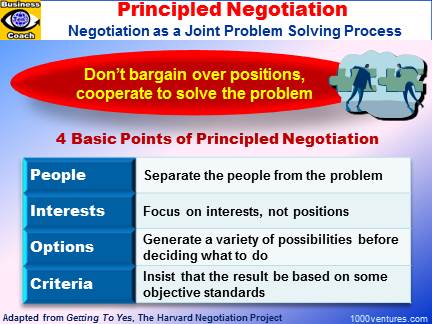
|
Principled Negotiation
The method called principled negotiation or
negotiation on the merits was developed by the leaders of the Harvard
Negotiation Project1. This method provides a much more effective alternative
to positional bargaining. The principled method permits you to reach a
gradual consensus on a joint decision efficiently and amicably.
In contrast to positional bargaining, the
principled negotiation method of focusing on basic interests, mutually
satisfying options, and fair standards typically results in a
wise agreement. Participants are problem solvers, not adversaries. An amicable
agreement between them is made possible by
separating the people from the
problem and dealing directly and empathetically with the other negotiator as
a human being.
The four points that define the principled
negotiation method are People, Interests, Options, and Criteria.
-
Separate the people from the
problem. Egos and emotions should not be entangled with the
objective merits of the problem and, thus, impede negotiations. Before
working on the substantive problem, disentangle the
people problem from
it and deal with it separately. The participants should come to see
themselves as working side by side attacking the problem, not each
other.
Solving People Problems
Selling
Is Problem Solving
-
Focus on interests, not positions.
Important is what people really want, not the positions they take.
Complementary interests serve as the building blocks for a wise
agreement. Realize that each side has multiple interests and look for
interests behind positions. Ask “Why?”, “What If?”, and “Why not?”
questions to put yourself in their shoes and uncover their interests.
-
Invent options for mutual gain.
Identify shared interests and look for mutual gains. Set aside a
designated time within which to think up a wide range of possible
solutions that advance shared interests and
creatively reconcile
differing interests. Consider
brainstorming with the other side.
-
Insist on using objective criteria.
The agreement must reflect some fair standard independent of the naked
will of either side. Law, custom, market value, or expert opinion could
serve as a fair standard...
More
Great Negotiator
Great negotiators build strong, durable,
win-win relationships because they have an obligation to help their
counterparts in negotiations come out winners...
More
Problem
Solving Strategies: 4 Levels
Selling by
Coaching
To be a
great salesperson, you must
treat your prospective customer as
a player who wants to achieve extraordinary results. You
are to help the player win....
More
|